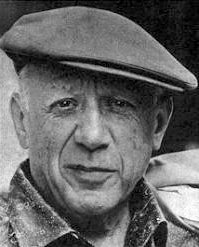INFORMATION - PEOPLE

... to remove himself from the perspectives of his time and place. He therefore worked within the boundaries of eurocentricity making associations between Africa and primitive savagery. Kahnweiler emphasised in particular Picasso’s use of African masks made by the Grebo people of the Ivory Coast and Liberia: one of which he purchased in 1912. The box shaped mouth and protruding cylindrical representations of eyes led Picasso to see that ‘art as a creation of signs..could become something like an emblem for the external world, rather than the window-like illusion of it so central to European art.’
In relation to this Picasso’s piece Bust of a Woman (1909) depicts the human form of a woman, but resembles an African carving due to the hatched, wooden effect evoked by the style of its production. Thus piece recently appeared in the exhibition ‘Afro-Modern: Journeys through the Black Atlantic’ at Tate Liverpool in early 2010. This exhibition explored the impact of black cultures from around the Atlantic on and within modern art, and included Picasso’s piece in Room One, which focussed on Black Atlantic Avant-Gardes, examining the convergence of modernism and the in early twentieth-century art. From this room it is clear that although European artists looked to African art for inspiration, in separating these artworks from their original African context and meaning they often misunderstood them.
Many European artists in the early 20th century had begun to appropriate the forms of African art and artifacts through a ‘primitivising’ gaze which was rooted in beliefs that a different direction in art, a new level of creativity, could be achieved through tapping into ‘divine inspiration’, by studying fetishised objects from Africa and the ‘non-Western’ or ancient worlds. These artists began to see non-Western art and culture as pure and intuitive, in opposition to what were considered the over-refined styles of ‘civilised’ European societies.
Gauguin is seen as the first artist to attach the notion of ‘primitivism’ to modern art. He did this through his numerous depictions of Tahitian natives. Hilton argues however, that Picasso was the first artist to really use ‘primitivism’ as a concept entirely, avoiding historicism and sentiment. He used it as technique rather than a subject. Picasso wanted to detach himself from what was known about art and so to approach it in a completely new way. African art demonstrated that art did not have to merely imitate the material world, but could be used as a spiritual representation of the external or invisible world. In using this approach Picasso could move away from the trappings of western art rules and have freedom to be totally expressive.
Roland Penrose discussed how ‘primitive art’ which had “formerly been despised and barbaric, began to be recognised as possessing great emotive strength.” Of course, there is a patronising element to this notion; non-western cultures and therefore their artistic products were often generalised as being naive, pure, without corruption, childlike in many ways. The ‘otherness’ of such artifacts had an attractive ‘exotic’ and ‘savage’ appeal to westerners.
Within Western perspectives then, there was no concept of a timeline to African art; it was treated as if no development or diversity had taken place in its entire history. Furthermore, Picasso had little anthropological interest in the African pieces he owned nor the specific, traditional meanings attached to them. In this way the idea of ‘primitivism’ is essentialist, Western avant-gardes selected what information they wanted to take from African art, the ‘exotic’, the natural simplicity, and ignored other aspects. Nonetheless, these ideas were the gateway to Picasso and others using forceful expressiveness to confound traditional notions of ‘beauty’ and ‘art’.
Following Picasso’s so-called discovery of African art as an influence, Parisian society in particular,became acutely interested in Africa and primitivism, leading eventually to the craze called ‘’ in the 1920’s. L’art nègre became a dominant force in many avant garde circles. Black artists, poets and writers were elevated to high status and it was fashionable to listen to jazz and dance the Charleston. Important African-American figures such as Claude McKay left America to experience Paris at this time. However the ultimate example of African-American success through the experience of Parisian society and the craze called ‘’ at the turn of the century is Josephine Baker. Singer, dancer, entertainer extraordinaire, whose purposeful effort to project an image that epitomised ‘primitivism’ made her the first black superstar. This attracted the attention of European avant-gardes, indeed Picasso called her ‘the Nefertiti of now’ and painted her portrait.
Although Picasso often downplayed the influence of African art in his work, Goldwater described it as ‘an ironic affirmation of total ignorance’, scholars agree the evidence is substantial. Picasso did more than reproduce African art and sculpture, he incorporated it into his vision of the world as did a number of his notable contemporaries and consequently they changed the direction of ‘Western art’. Broadly ‘primitivism’ consisted in large part of appropriating the forms of non-Western art and was built around racialised concepts of ‘primitive’ cultures. Nevertheless, Picasso was a significant harbinger of the interest in African art and culture in the West, which contributed to the first opportunities for African diasporas to express themselves culturally on public platforms within the western world.
Contributed by: HGF
 |
Continue the debate on 'Primitivist Picasso' here |
Return to People home